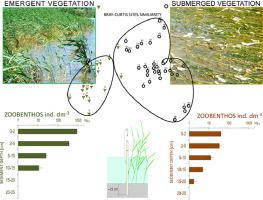Oceanologia ( IF 2.9 ) Pub Date : 2022-10-31 , DOI: 10.1016/j.oceano.2022.10.002 Krzysztof Pawlikowski , Ryszard Kornijów

|
The contrast in habitat complexity between emergent (EMV) and submerged vegetation (SUV) zones in aquatic ecosystems results from the differences in the structure of plant above- and belowground parts, subject to seasonal changes. Comparative studies on the influence of habitat complexity created by vegetation on benthic macroinvertebrates in coastal areas are scarce. In order to fill this knowledge gap, we performed a study on a seasonal basis in the brackish Vistula Lagoon (southern Baltic Sea) in two zones: EMV, dominated by a dense belt of Phragmites australis (Cav.) Trin. ex Steud, and SUV, with scattered stands of Potamogeton perfoliatus L. We assumed the following: i. Species richness, diversity, and density of invertebrates are higher in the EMV zone due to greater and less seasonally variable structural complexity than in the SUV zone, ii. High belowground complexity in the EMV zone due to the presence of the rhizome/root matrix, much more robust and denser than in the SUV zone limits the vertical distribution of macroinvertebrates. Both hypotheses were supported. Overall, our results pointing to higher animal diversity and density in more complex aquatic habitats are consistent with other studies, inferred mostly from comparative surveys of bare bottom and that covered with submerged vegetation. The results of this study highlight potentially far-reaching implications for benthic invertebrate fauna and their role in the aquatic ecosystem in the context of increasingly rapid loss of aquatic vegetation due to multiple anthropogenic stressors.
中文翻译:

由挺水和沉水植被造成的地上和地下栖息地复杂性驱动着底栖生物群落的结构
水生生态系统中挺水 (EMV) 和沉水植被 (SUV) 区域之间生境复杂性的差异源于植物地上部和地下部结构的差异,受季节变化影响。关于植被造成的栖息地复杂性对沿海地区底栖大型无脊椎动物影响的比较研究很少。为了填补这一知识空白,我们在咸水维斯杜拉泻湖(波罗的海南部)的两个区域进行了季节性研究:EMV,主要是芦苇(Cav.) Trin的密集带。ex Steud 和 SUV,散布着Potamogeton perfoliatus L。我们假设如下:i。由于季节性变化的结构复杂性比 SUV 区更大和更小,因此 EMV 区的物种丰富度、多样性和无脊椎动物密度更高,ii 。由于根茎/根基质的存在,EMV 区地下高度复杂,比 SUV 区更坚固、更密集,限制了大型无脊椎动物的垂直分布。这两个假设都得到了支持。总的来说,我们的结果表明在更复杂的水生栖息地中动物多样性和密度更高,这与其他研究一致,主要是从裸底和被淹没植被覆盖的比较调查中推断出来的。这项研究的结果强调了在多种人为压力因素导致水生植被日益迅速丧失的背景下,底栖无脊椎动物群及其在水生生态系统中的作用可能具有深远影响。



























 京公网安备 11010802027423号
京公网安备 11010802027423号